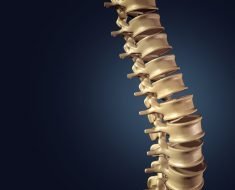Fidget to stay in shape! Experts say going for a walk or run is no good if you then sit down all day… but there is another surprising way to stay healthy
My heart sank when the news of lockdown 2.0 was first announced. It’s not just the lack of contact with friends that concerns me, but the effect it’s going to have on my body.
I’ve seen first-hand how quickly even two weeks’ confinement can wreak havoc on weight, muscle mass and body age — and how damaging curling up on the sofa can be, even if you do keep up with exercise.
After returning from a family holiday in France this summer, I did my 14 days’ quarantine, which meant I was unable to leave the house at all. I worked from home and kept fit with an hour of daily Pilates. I weigh 11 st 10 lb; healthy for my 5 ft 10 in frame.
But after two weeks my body composition scales offered a sobering insight into what was really going on.
These devices work by sending an electrical current through your feet to measure muscle mass, bone density, body water percentage and fat — combining these results with your age and height, it calculates your metabolic age.

My heart sank when the news of lockdown 2.0 was first announced. It’s not just the lack of contact with friends that concerns me, but the effect it’s going to have on my body [File photo]
I am 49 but my scales were now telling me my metabolic age had increased to 58 from 48 in a matter of days. My body fat percentage went up from 33.8 per cent to the highest I’ve seen it — 38 per cent, with the scales labelling me ‘obese’.
My visceral fat (which sits around our abdominal organs and which is most detrimental to our health) had also gone up, while my muscle mass had deteriorated from 106 lb to 100 lb, even though I also put on 4lb.
It’s not just me. A survey by King’s College London and Ipsos Mori in May revealed 48 per cent of us put on weight during the first lockdown. And research examining the effects of lockdowns, published in the journal Nutrients in June, found just a few weeks of reduced daily activity — even without eating more — could lead to weight gain.
But experts say it’s not a lack of formal exercise that is tripping us up, but rather the lack of NEAT — Non-Exercise Activity Thermogenesis.
These are, essentially, all the incidental movements you make during the day, from shopping to brushing your hair.
‘NEAT is the energy you expend throughout daily life apart from eating, sleeping and exercise,’ says Andrew Shepherd, a sport and exercise nutritionist at Loughborough University. ‘This might be walking to work or gardening, all the way through to fidgeting,’ he adds.
Ensuring you have enough of this ‘non-exercise’ activity in your day is better for you than sporadic bursts of formal exercise, adds Professor Mike Loosemore, a consultant sports physician at the Institute of Sport, Exercise & Health in London.
‘Although formal exercise is good for you, there is a separate risk factor in not keeping your NEAT activity up.

Experts say it’s not a lack of formal exercise that is tripping us up, but rather the lack of NEAT — Non-Exercise Activity Thermogenesis. These are, essentially, all the incidental movements you make during the day, from shopping to brushing your hair [File photo]
‘If you sit down all day and run 5km, excellent. But you haven’t got rid of the risk factor of sitting down. When we sit, our muscles aren’t working and we are ticking over in a low metabolic state,’ he says. ‘This means when you have something to eat, it’s stored away as fat, often round our middles, because you’re not using it and our metabolic rate is low.’
Professor Loosemore is not surprised about the results of my scales as he says any reduction in NEAT affects us ‘quite badly’.
Too many people think they can slump on the sofa if they go for a run — when in fact it’s only when you train at a very high rate — at 80 per cent of our maximum for at least 20 minutes — that our metabolic rate remains raised after exercise, adds Eliza Flynn, a personal trainer at The Warrior Method centre in London.
As soon as I was allowed out of the house after my holiday quarantine, I stepped up training at the Lea Rowing Club — I’m a former Oxford Blue and England rower — and completed a wet and windy ‘virtual’ London Marathon in a respectable five hours and 45 minutes on October 4.
I was relieved when my scales began to return to normal. Until, that is, I was forced to spend another five days in isolation after a contact tested positive for Covid-19.
The confinement had an immediate effect, even though I continued to train — doing circuit workouts and Pilates — because I was not moving enough in between.
Public Health England advises us to aim for 30 minutes of daily exercise. But physical activity guidelines published by the Chief Medical Officer in September 2019, also state: ‘Adults should aim to minimise the amount of time spent being sedentary, and when physically possible should break up periods of inactivity with at least light physical activity.’
Dr Carolyn Greig, a reader in musculoskeletal ageing and health at the University of Birmingham, says the evidence is unequivocal: sitting still for long periods will damage your health — whatever your age.
‘As well as encouraging people to be more active, we must encourage them to be less sedentary. It’s important in its own right. I am a weekend warrior but spend the week at my desk. It doesn’t matter that I’ve been active during the weekend — the fact I’m inactive during the week isn’t healthy.’
Indeed a seminal study, published in October 2018 in the American Journal of Epidemiology, found those who sit for six or more hours a day have a higher risk of premature death from a wide range of causes, such as cardiovascular disease, cancer, diabetes, and Alzheimer’s, than those who sit for fewer than three hours.
The problem we face now is a double-whammy of lockdown at a time when daylight hours are diminishing.
Andrew Shepherd says: ‘We see a lot more incidental activity in the summer due to people spending time outdoors gardening or washing the car and there is simply more time to do things which act as NEAT.’
Those of us working from home have an additional challenge, he says. ‘NEAT is hugely impacted by working from home. You might need to consider how big your office was, how long your commute was, whether you drove or caught public transport,’ he says.
‘A useful thing to do is to use a tool such as a step counter to make a comparison between your steps before lockdown and after.’
The good news is every bit of movement helps. Professor Loosemore says: ‘There is good evidence that fidgety people don’t put on as much weight as non-fidgety people.’ And a 2015 study published in the American Journal of Preventive Medicine concluded that fidgeting ‘may reduce the risk of all-cause mortality associated with excessive sitting’.
Fidgeting counts as anything from shifting sitting position regularly, to toe tapping, and twiddling your thumbs, to playing with your hair, adds Eliza Flynn.
Andrew Shepherd suggests that while no one hour of exercise ‘is ever going to balance a dramatic loss of NEAT, there are simple things you can do each day to prevent being totally sedentary.
‘Start by becoming aware of how much NEAT you’ve lost and be mindful of how you replace that, as more rigorous exercise isn’t going to replace 10,000 steps walking around an office,’ he says.
The answer may be as simple as standing more.
Professor Loosemore told Good Health that if we all stand for three hours a day, after a year we would have burned as many calories as running ten marathons.
‘Standing burns 0.7 calories more a minute than sitting. That’s 8lb of fat over a year.’
So don’t sit out this lockdown — stand up for your health and get fidgeting.
How to exercise without realising it!
To get more non-exercise activity into your day, personal trainer Eliza Flynn suggests the following:
- Start your day with five minutes of resistance exercise: 60 seconds of squats, lunges, press-ups, heel raises and a plank. If you’re older, getting out of a chair without using your hands expends extra energy and is good for mobility. Or stand near a wall in case you need support and take one foot off the ground. Count how long you can do this and improve by a second a day.
- Introduce the 20/20 rule — for every 20 minutes you sit, move for 20 seconds: go to the loo, grab a glass of water, stand and stretch, have a wriggle. Set a timer to remind you.
- Work standing up for some of the time — set up your computer on your kitchen counter. But mix it up by moving to sitting.
- Pace the room while on the phone.
- Put clothes on while standing up, to work your balance and coordination.
- Dry your hair while you’re on your feet.
- Instead of walking to the closest shops, pick some further away. Carrying shopping is a good strength workout, but use a comfy, large rucksack rather than shoulder bags or carrier bags.
- Sit on the floor when watching TV — you’ll find that you shift positions more often.
- Use the stairs in your house more. Instead of taking things up all in one go, take them individually as and when needed.
- Loop a long resistance band (like a large elastic band) around a secure piece of furniture or door handle in a place where you spend ‘dead time’, such as waiting for the kettle to boil or when on the phone.
Do ten to 20 seconds of bicep curls (take band in one hand and pull towards shoulders) or front raises (stand with your back to the door, one band in each hand and raise straight arms to shoulder height).
Source: Read Full Article





